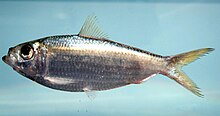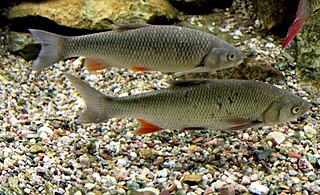
The common chub, also known as the European chub or simply chub, is a species of European freshwater ray-finned fish in the carp family Cyprinidae, that frequents both slow and moderate rivers, as well as canals, lakes and still waterbodies of various kinds.

Herring are forage fish, mostly belonging to the family of Clupeidae.

Sardine and pilchard are common names for various species of small, oily forage fish in the herring suborder Clupeoidei. The term 'sardine' was first used in English during the early 15th century; a somewhat dubious etymology says it comes from the Italian island of Sardinia, around which sardines were once supposedly abundant.

The king mackerelsurmayi or kingfish, is a migratory species of mackerel of the western Atlantic Ocean and Gulf of Mexico. It is an important species to both the commercial and recreational fishing industries.

The Atlantic Spanish mackerel is a migratory species of mackerel that swims to the northern Gulf of Mexico in spring, returns to southern Florida in the eastern Gulf, and to Mexico in the western Gulf in the fall.

The school shark is a houndshark of the family Triakidae, and the only member of the genus Galeorhinus. Common names also include tope, tope shark, snapper shark, and soupfin shark. It is found worldwide in temperate seas at depths down to about 800 m (2,600 ft). It can grow to nearly 2 m long. It feeds both in midwater and near the seabed, and its reproduction is ovoviviparous. This shark is caught in fisheries for its flesh, its fins, and its liver, which has a very high vitamin A content. The IUCN has classified this species as critically endangered in its Red List of Threatened Species.

The European sprat, also known as brisling, brisling sardine, bristling, garvie, garvock, Russian sardine, russlet, skipper or whitebait, is a species of small marine fish in the herring family Clupeidae. Found in European, West Asian and North African waters, it has silver grey scales and white-grey flesh. Specific seas in which the species occurs include the Irish Sea, Black Sea, Baltic Sea and Sea of the Hebrides. The fish is the subject of fisheries, particularly in Scandinavia, and is made into fish meal, as well as being used for human consumption. When used for food it can be canned, salted, breaded, fried, boiled, grilled, baked, deep fried, marinated, broiled, and smoked.
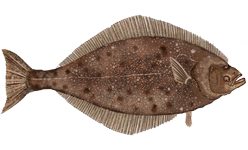
Hippoglossus stenolepis, the Pacific halibut, is a species of righteye flounder. This very large species of flatfish is native to the North Pacific and is fished by commercial fisheries, sport fishers, and subsistence fishers.
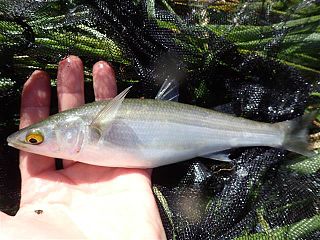
Yellow-eye mullet, also known as Coorong mullet, conmuri, estuary mullet, Forster's mullet, freshwater mullet, pilch, pilchard, Victor Harbor mullet, yelloweye and yellow-eyed mullet, are small, near-shore fish found in temperate waters of southern Australia from just north of Sydney, New South Wales to Shark Bay in Western Australia, around Tasmania, and New Zealand.

The Atlantic thread herring is a herring-like fish in the family Clupeidae.

The mangrove snapper or gray snapper is a species of snapper native to the western Atlantic Ocean from Massachusetts to Brazil, the Gulf of Mexico, Bermuda, and the Caribbean Sea. The species can be found in a wide variety of habitats, including brackish and fresh waters. It is commercially important and is sought as a game fish. It can also be found in the aquarium trade.
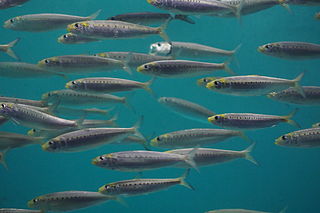
Sardinops is a monotypic genus of sardines of the family Alosidae. The only member of the genus is Sardinops sagax. It is found in the Indo-Pacific and East Pacific oceans. Its length is up to 40 cm (16 in). It has numerous common or vernacular names, some of which more appropriately refer to subspecies, including blue pilchard, Australian pilchard, blue-bait, Californian pilchard, Peruvian Pacific sardine, South American pilchard, Chilean sardine, Japanese pilchard, Pacific sardine, and Southern African pilchard.

The yellowtail horse mackerel, also known as yakka, is a jack in the family Carangidae found around Australia and New Zealand at depths to 500 m. Its length is up to 50 centimetres (20 in).

Forage fish, also called prey fish or bait fish, are small pelagic fish that feed on planktons and other small aquatic organisms. They are in turn preyed upon by various predators including larger fish, seabirds and marine mammals, this making them keystone species in their aquatic ecosystems.

The bluespotted trevally, also known as the wide-mouthed trevally, is a species of moderately large marine fish in the jack family Carangidae. The bluespotted trevally is distributed through the tropical east Indian and west Pacific Oceans, ranging from Taiwan in the north to Australia in the south. It is an inshore species, found in sandy, muddy and seagrass environments, often in large bays. The bluespotted trevally is distinguished by dark blue spots on its upper body, as well as a number of more detailed anatomical features. It is a benthopelagic predator, taking a variety of crustaceans including crabs and prawns as a juvenile, before shifting to a more fish-dominated diet as an adult. It is one of the most common predators in the Gulf of Carpentaria of northern Australia, and is considered the most important predator of commercially important prawn species. Sexual maturity is reached at 110 mm in length and one year of age, with spawning occurring year round with a peak in spring. Growth is estimated to be 82.2 mm per year for both sexes, reaching a maximum known length of 66 cm. Bluespotted trevally are commonly taken as bycatch in prawn fisheries, however are of little commercial value and often discarded. They are occasionally taken by anglers on lures and baits, but are considered mediocre table fare.

A bait ball, or baitball, occurs when small fish swarm in a tightly packed spherical formation about a common centre. It is a last-ditch defensive measure adopted by small schooling fish when they are threatened by predators. Small schooling fish are eaten by many types of predators, and for this reason they are called bait fish or forage fish.

The European pilchard is a species of ray-finned fish in the monotypic genus Sardina. The young of the species are among the many fish that are sometimes called sardines. This common species is found in the northeast Atlantic, the Mediterranean, and the Black Sea at depths of 10–100 m (33–328 ft). It reaches up to 27.5 cm (10.8 in) in length and mostly feeds on planktonic crustaceans. This schooling species is a batch spawner where each female lays 50,000–60,000 eggs.

Sardines ("pilchards") are a nutrient-rich, small, oily fish widely consumed by humans and as forage fish by larger fish species, seabirds and marine mammals. Sardines are a source of omega-3 fatty acids. Sardines are often served in cans, but can also be eaten grilled, pickled, or smoked when fresh.
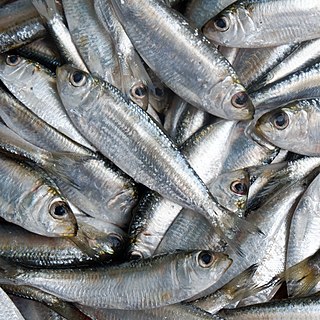
Sardinella tawilis is a freshwater sardine found exclusively in the Philippines. It is the only member of the genus Sardinella known to exist entirely in fresh water. Locally, they are known in Filipino as tawilis.

Amblygaster sirm, the spotted sardinella, also known as the northern pilchard, spotted pilchard, spotted sardine, and trenched sardine, is a reef-associated marine species of sardinellas in the herring family Clupeidae.
